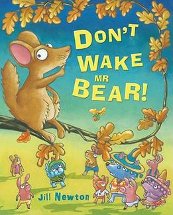Don't wake Mr Bear! by Jill Newton

Egmont, 2011. ISBN 9781405249669.
The first golden oak leaf floating to the ground was the signal for
the autumn orchestra to begin the lullaby of the forest. Dormouse
played his triangle, the squirrels their flutes, the wood pigs
tapped their xylophones and the rabbits strummed their harps. It was
perfect music to send Mr Dormouse off for his long winter sleep.
And, as he left, he warned them not to wake Mr Bear. Unfortunately,
no one told the wolves and when they crashed into a tree making all
sorts of noise and ready to party, the inevitable happens.
But not only is Mr Bear woken, so is Dormouse and he has a very
serious message about the importance of the rhythms of nature and
the need for things to sleep.
With this summer being what it is, particularly on the East coast,
the weather is a common conversation and autumn will soon be upon
us. Thus, this is a delightful book to introduce the changing of the
seasons, and although the creatures are not Australian, it's an
ideal time to widen the children's horizons and have them
investigate why animals hibernate, why some species lose their
leaves and rather than winter being a time of little life, it is, in
fact a time of rest and renewal. It's a bit like night time for
people, only longer.
This book has bright colourful illustrations that are very appealing
and there are lots of opportunities for listeners to join in using
their body orchestra. How can you make the sound of the breeze
without a flute? How can you make the sound of the nuts falling
without an xylophone? And having talked about the different rhythms
from the legato of the flute to the staccato of the xylophone, the
children could then experiment and classify the instruments
accordingly. A music lesson in the library? Why not? And all part of
the information literacy process as they learn to hypothesise, group
like with like, and present their findings.
Barbara Braxton